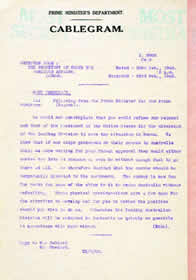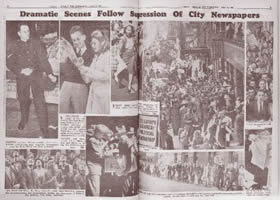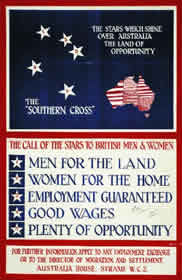
BROADENING HORIZONS
Man of his Word
Without any inhibitions of any kind I make it quite clear that Australia looks to America, free of any pangs as to our traditional links or kinship with the United Kingdom.
(John Curtin, 1941)
1942 was a critical year for Australia as the war came to our doorstep. In the weeks after Pearl Harbour and the sinking of the British battleships Prince of Wales and Repulse, Curtin expressed growing concern about Australia’s reliance on Britain and the naval base at Singapore. As it became increasingly obvious that Singapore would fall, it was clear that Australia needed a new ally.
Look to America
Curtin’s turn towards America was for pragmatic reasons as was the Americans’ response in setting up their Pacific Headquarters here. Curtin was well aware that once the Americans ‘no longer needed to use Australia as a convenient base, the American forces would move on, without a backward glance at the subsequent fate of the Australian people.’ (Peter Edwards, 2001)
Cablegram War
While negotiating with US President Franklin Roosevelt for American forces to come to Australia, Curtin was also locked in a strategic battle with British Prime Minister Winston Churchill. The exchange of cablegrams between Curtin and Churchill in February 1942 concerning the return to Australia of the 6th and 7th Divisions of the AIF for Australia’s defence and security, is widely regarded as an important stage in Australia’s evolution from dependence on Great Britain.
Overseas Meeting
In 1944 Curtin took an overseas trip to the US and UK to meet with Roosevelt and Churchill and attend the Dominion Prime Ministers Conference. It was an opportunity to strengthen these two important relationships for Australia.
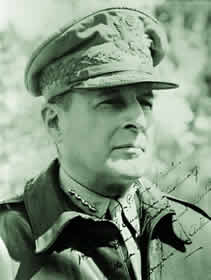
Photograph from General Douglas MacArthur to Prime Minister John Curtin.
John Curtin Prime Ministerial Library. Records of the Curtin family. General Douglas MacArthur, c1944. Inscribed. JCPML00376/124
In March 1942 General Douglas MacArthur arrived in Australia as the Supreme Commander of the South West Pacific.
Curtin was determined to have Australian troops return to protect Australia and Churchill was equally determined to have Australian troops protect Burma. Churchill considered Burma vital in maintaining effective communication between the Allies and China, whose resistance to the Japanese was important, and for the defence of India.
Cablegram from Churchill to Curtin, 22 February 1942.
Courtesy National Archives of Australia: A816, 52/302/142
CHANGING OUR IMAGE
Censorship
The principal agency responsible for censorship and publicity during World War II was the Department of Information.
The Department’s responsibilities included the censorship of all media, the management of shortwave broadcasting (which later became Radio Australia), the production and distribution of cinematographic films, the coordination and procurement of government advertising, the publication and distribution of pamphlets, posters and photos, the provision of editorial material to local and overseas media and the maintenance of public morale. (John Hilvert, 1984).
Censorship was influenced by political as well as military matters. The Curtin Government wanted to promote an image of Australia as a worthy Ally in the war and established the Department as the point of dissemination for overseas information. After MacArthur’s arrival in 1942, the Censor also had to cope with demands from the American armed services.

‘Snapped’. Cartoon by Will Mahony in Daily Telegraph, 3 June 1943.
Australia’s most notorious censorship incident occurred in April 1944 when publication of daily newspapers was suppressed. Defying censorship instructions the Daily Telegraph published comments on the damaging coal strikes. This prompted Calwell to require the paper to submit all its stories before publication. A war of words broke out between the newspaper and Calwell. The Sunday Telegraph submitted its stories to the Censor but flouted requirements by printing the articles with large blank spaces. A warning to fill in the blanks was ignored and further distribution of the paper was suppressed. The matter eventually went to court.
Publicity
The Department of Information continued its work until 1950. In the postwar years it promoted Australian trade and tourist possibilities abroad and encouraged Australians to overcome their aversion to non-British migrants. In 1945 the Commonwealth Immigration Advisory Council warned that ‘A national publicity campaign should be launched conditioning the Australian citizen for the arrival of migrants, assuring him that the new citizen will make jobs not take them, and educating the public out of its isolationist “attitude” to the new arrivals.’ (Nonja Peters, 2001). It was the Department of Information’s role to teach Australians to accept the new arrivals with their different looks, languages, food and customs. A massive publicity campaign was launched using high profile community members and leaders to extol the benefits of migration through posters, radio advertising and newsreel broadcasts.
AUSTRALIA ON THE WORLD STAGE
Man of his Word
Our generation will have left its mark before we hand on the torch to our sons and daughters. Our remaining task is to think and plan so that their world may in truth be a new world. There can be no going back to the good old days. They were not good days and they have truly become old. We have to point the way to better days.
(John Curtin, 1944)
Curtin and his government laid the foundation for Australia’s increasing engagement with the emerging global economy and world affairs by helping to establish the United Nations, signing the ANZAC Treaty as a prelude to ANZUS, and participating in the Bretton Woods Agreement which led to the International Monetary Fund (IMF), the World Bank and the General Agreement on Trade and Tariffs (GATT).
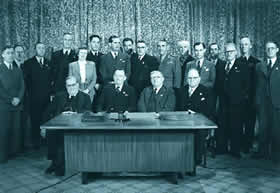
Group portrait of Australian delegates to United Nations Conference (1945) with the delegation leaders Deputy Prime Minister Frank Forde (second from left, seated) and Minister for External Affairs Herbert Evatt (second from right, seated). The only woman in the photograph (and the only woman on Australia's delegation), Jessie Street, took an active part in the committees set up to establish the Human Rights Commission and the Commission on the Status of Women of which she became the first vice-president.
Courtesy National Library of Australia: PIC an23236247
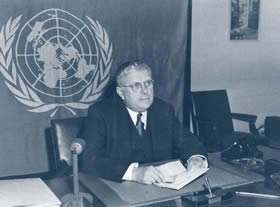
Dr H V Evatt at the United Nations.
Courtesy National Archives of Australia: A6180, 23/8/79/118
The UN Charter was signed by 50 countries at San Francisco on 26 June 1945 and came into force on 24 October 1945 after it had been ratified by a majority of signatory countries and the permanent members of the Security Council. Dr Evatt became President of the United Nations.
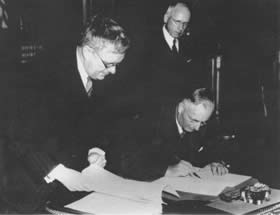
Curtin flanked by Dr Evatt (right) and Prime Minister of New Zealand, Peter Fraser (left), signs the ANZAC Treaty.
John Curtin Prime Ministerial Library. Records of Douglas MacArthur. PM John Curtin signing a document watched by H.V. Evatt and NZ PM Peter Fraser, 194? JCPML00265/20. Original held by MacArthur Memorial Library and Archives: MML&A 20082
The ANZAC Treaty was Australia’s first international treaty signed independently of Britain.
Bretton Woods
In July 1944 a United Nations Monetary and Financial Conference was held at Bretton Woods, a mountain resort in New Hampshire in the USA. By the conclusion of the conference delegates agreed to set fixed exchange rates for major currencies and to establish two permanent international bodies: the International Monetary Fund and the International Bank for Reconstruction and Development (later the World Bank).
There was much anxiety within Australia and particularly within Labor Party circles that a major effect of the agreement would be pressure for Australia to reduce its tariff protection levels and forego its trading advantages with the UK. It took three years of tough debate before Australia ratified the agreement in March 1947. Securing Australia’s ratification of the Bretton Woods Agreement was one of the most politically difficult but important achievements of the Curtin and Chifley Governments in preparing Australia for its place in the postwar world of international trade and economics.
United Nations
During the San Francisco conference of April to June 1945 Australia was represented by Deputy Prime Minister Frank Forde and Minister for Foreign Affairs, Dr Herbert Evatt. Evatt worked hard to make Australia an active voice for the small powers. While not able to influence the major countries to give up their power of veto, he did have some success in altering the Charter to better reflect the concerns of the small countries. Evatt became the first President of the United Nations, a very prestigious position for Australia.
ANZUS Treaty
While Curtin advocated some form of permanent organisation for the British Commonwealth after the war, it was increasingly apparent that Australia depended on the US for security and wanted the US to take a more permanent interest in the Pacific.
In 1944 Australia had joined with New Zealand in signing the ANZAC Treaty which could be considered the forerunner of the 1951 tripartite ANZUS agreement to establish the US as its primary ally in the Pacific. With the advent of the Korean War, the ensuing Cold War, and the establishment of Communist China, the US became concerned that Communism would spread to the Far East and a Pacific pact involving the US, Australia and New Zealand therefore became a practical proposition. The Australian Minister for External Affairs, Percy Spender, was able to negotiate a defensive military arrangement in the Asia-Pacific region. The ANZUS Treaty was signed by the three governments in September 1951 and came into operation at the end of April 1952.

